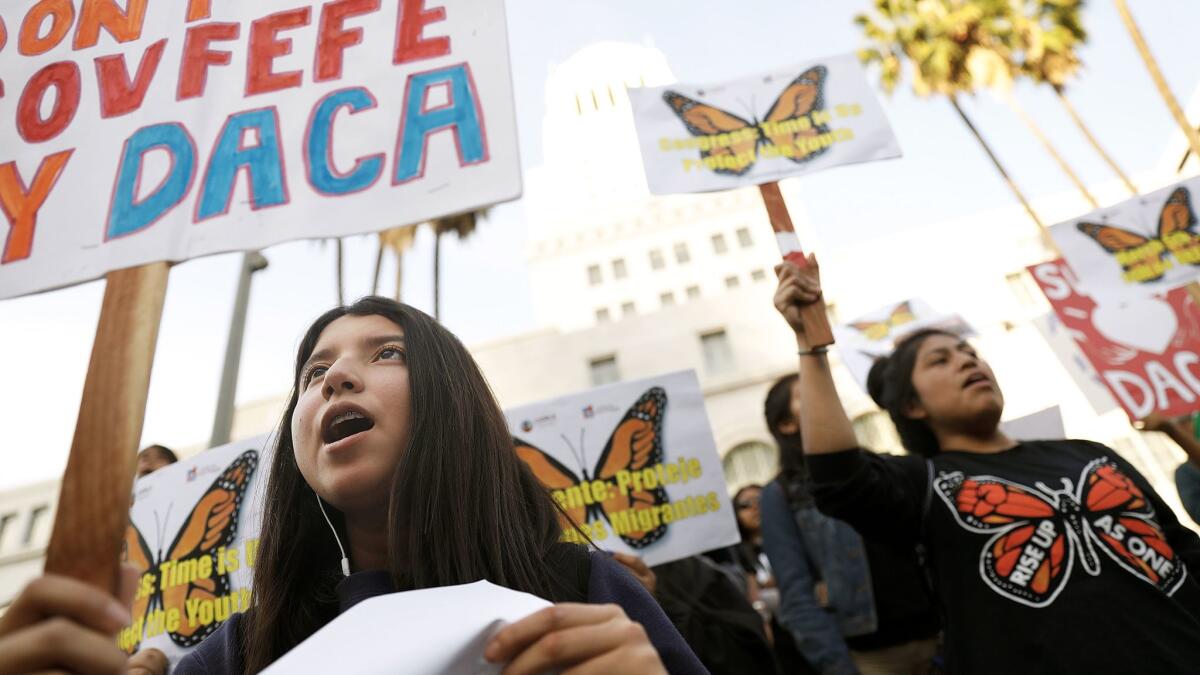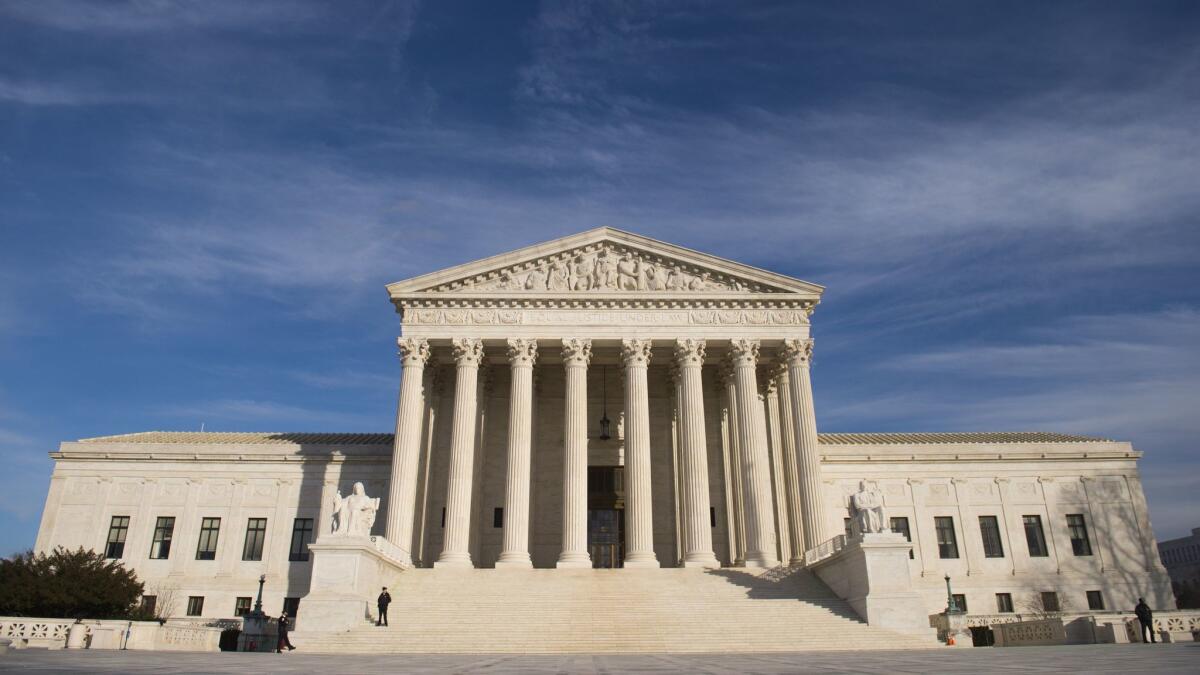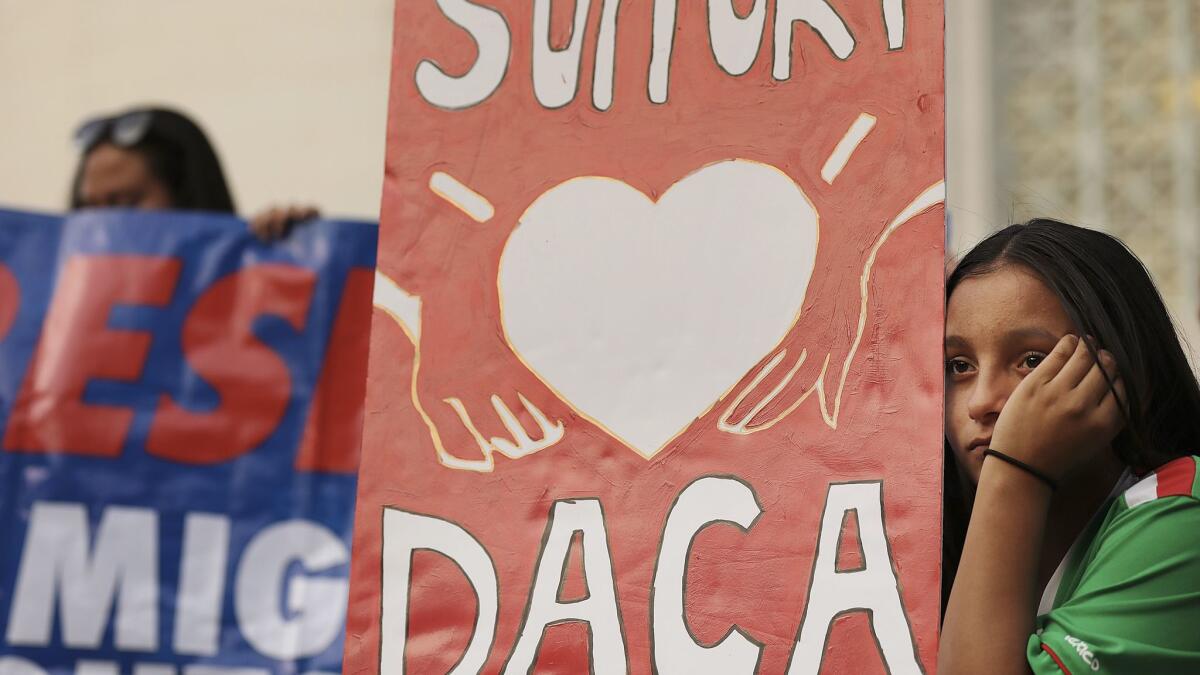What’s next for DACA? As deadline arrives with diminished urgency, here’s where the program stands

Reporting from San Diego — A program that temporarily shields hundreds of thousands of young people from deportation was scheduled to end Monday but court orders have forced the Trump administration to keep issuing renewals, easing the sense of urgency.
In September, Trump said he was ending the Deferred Action for Childhood Arrivals program but gave Congress six months to develop a legislative fix. Those whose permits expired by Monday had one month to apply for renewal.
A nationwide injunction in January by U.S. District Judge William Alsup in San Francisco required the administration to resume renewals but does not apply to first-time applicants.
Here is where DACA stands on the day it was set to expire:
What is DACA?
President Obama introduced DACA in June 2012 by executive action, giving hundreds of thousands of people who came to the country illegally as children two-year, renewable permits to live and work. To qualify, they needed to have arrived before their 16th birthday, been under 31 in June 2012, completed high school or served in the military, and have no criminal record.
Nearly 683,000 people were enrolled at the end of January, eight out of 10 from Mexico.

Where do the courts stand on DACA?
Alsup ruled Jan. 9 that the administration failed to justify ending the program and that the plaintiffs — the states of California, Maine, Maryland and Minnesota as well as the University of California — had a good chance of winning at trial. His nationwide injunction required the administration to resume accepting renewal requests within a week.
U.S. District Judge Nicholas G. Garaufis in New York later issued a similar ruling.
On Feb. 26, the U.S. Supreme Court denied the administration’s unusual request to intervene, which would have leapfrogged the appeals court.
The 9th Circuit Court of Appeals put its review of Alsup’s decision on fast track, but legal experts don’t expect a decision until June at the earliest. From there, it is expected to go to the Supreme Court, likely keeping DACA alive through the November midterm elections.
Is Monday’s deadline no longer meaningful?
Courts have removed much of the urgency, but DACA recipients whose applications are pending are at risk until their petitions are granted.
Former Homeland Security Secretary John Kelly, now Trump’s chief of staff, last year scrapped the Obama administration’s policy of limiting deportations to people who pose a public safety threat, convicted criminals and those who have crossed the border recently, effectively making vulnerable anyone in the country illegally. Deportation arrests have surged more than 40% under Trump.
There were nearly 14,000 people with expired permits who applied for renewals but hadn’t received them at the end of January. There were also nearly 22,000 whose initial applications had yet to be decided.
DACA advocates are using Monday’s deadline to intensify pressure on the White House and Congress for permanent protection. The ACLU said Sunday that it launched “multiple six-figure advertising buys” with United We Dream and MoveOn.org, focusing on Trump.

Where does Congress stand on DACA?
In January, the president proposed a path to citizenship for 1.8 million young immigrants as part of an immigration package that included $25 billion for a wall and other border enforcement measures and sharp cuts to legal immigration. The Senate rejected it.
Immigrant advocates and their allies in Congress want a narrower bill that would protect DACA recipients, possibly combined with limited border enforcement measures, but the administration has balked. Trump has repeatedly blamed Democrats for the impasse, while Democrats say he created it by ending DACA.
Congress must pass a spending bill by March 23 to keep the government running, giving Democrats a chance to condition support on a DACA bill. Democrats forced a partial shutdown in January with that goal in mind but relented after three days.
Stephen W. Yale-Loehr, a Cornell University law professor, says the Supreme Court’s refusal to intervene “throws the DACA program back into Congress’ lap.”
More to Read
Get the L.A. Times Politics newsletter
Deeply reported insights into legislation, politics and policy from Sacramento, Washington and beyond. In your inbox three times per week.
You may occasionally receive promotional content from the Los Angeles Times.










